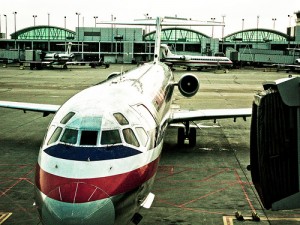The Price of Air Travel
The cost of air travel is going up, and airlines are counting on us not to notice.
I’m not talking about airfares, which have actually declined in real terms over the past decade, despite inching up in the past few years. And I don’t mean the ancillary fees to check a bag, check in at the airport, speak to a live agent, or pick your seat, though these, too, are going up. Instead, I’m talking about the cost of delays and schedule disruptions that waste travelers’ time and force them to travel earlier to their destinations or risk missing important meetings and events.
Air travel in the U.S. is becoming less reliable and less resilient to shocks like isolated storms that can ripple through the system and impact passengers thousands of miles away. If anti-trust authorities approve the merger between American and US Airways, we should expect things to get worse.
On a recent trip to Boston for an economics workshop, United canceled my flight out of Raleigh twice before eventually putting me on a rival Delta aircraft. With two flights from Raleigh to United hubs cancelled that morning, the queue for rebooking was long, and some passengers were likely stranded until the next day. On the trip home, my United flight was so delayed that I would have missed my connection if I had taken the original flight. So United again put me on a Delta plane that was ultimately also delayed. And a few weeks ago, a friend was delayed on United out of La Guardia. The airline automatically rebooked him—for travel two days later!
Researchers at MIT and George Mason University estimate that delayed and canceled flights imposed on passengers an aggregate delay of 28,500 years in 2007. The cost of these delays, and of risk-averting behavior like traveling early to destinations, was estimated at $15.3 billion, a startling number that accounts for the opportunity cost of time but doesn’t measure the consequences of missing critical appointments like weddings or job interviews.
Department of Transportation statistics suggest reliability improved in 2012 relative to 2011 and is not much worse than a decade ago, with only 16 percent of flights delayed 15 minutes or more and only 1 percent cancelled. But such statistics belie the true state of air travel in the U.S. and the fragility of airline networks. As USA Today reported earlier this year, airlines have padded flight times in order to improve on-time performance. As a consequence, fewer flights are recorded as late arrivals and the share of flights arriving early has quintupled since 1996 to 20 percent. Even with padded arrival times, however, connecting passengers face a 30 percent or greater chance of experiencing delays.
Airlines are increasingly consolidating service at the nation’s largest airports, according to a report this summer from MIT. Meanwhile, the number of large hubs has declined from 20 to 10, even as the number of flights channeled into large hubs has grown 75 percent.
This means an ever-larger share of passengers must make connections in an ever-fewer number of airports, including those in the most congested airspace in the country. If weather, security, or accidents halt or slow operations at one of those airports, effects can reverberate throughout the system, as late-arriving aircraft delay flights downstream elsewhere around the country. United passengers should find this particularly alarming as five of the airline’s hubs rank among the six worst airports in the country for on-time departures.
Because airlines are also cutting routes and boosting loads, they are increasingly less able to accommodate disrupted passengers, leading to days-long delays. Fourteen percent fewer flights were offered in 2012 than in 2007, while aircraft load factors reached a seasonal record in February and have averaged about 83 percent since 2012, well above the loads in the mid 70s typically observed a decade ago.
In adopting fragile networks, airlines are shifting costs onto passengers in a way they hope will be less likely than fare increases to attract the attention of consumers and regulators. Fare competition is relatively fierce because prices are fairly transparent, particularly so with online travel agents and fare aggregators like Orbitz and Kayak.
Network reliability, on the other hand, is largely a shrouded attribute, insalient to consumers who cannot readily compare the reliability of competing itineraries ex ante nor assign blame to various parties like Mother Nature, air traffic control, and airlines ex post—unless they are expert travelers like Ben Schlappig. Consequently, airlines needn’t compete as aggressively along this dimension as they do over fares. So they minimize expenditures on preventive maintenance, spare planes, spare parts, and spare flight crews, and eke out efficiencies gained from larger, though brittle, hub operations—effectively delivering customers a less-reliable product.
Late arriving aircraft were the leading cause of delays in 2012, responsible for more than 12 times as many delays and cancellations as weather. Aircraft positioning is assuredly within airline control.
In reviewing the proposed merger of American and US Airways, anti-trust authorities should be mindful not only of changes in prices as the industry consolidates but also of changes in product quality, particularly as air transport seems increasingly susceptible to breaking. And as airlines build networks with less resilience to weather, mechanical problems, accidents, and other unforeseen events, remember who is to blame the next time you misconnect.


Comments